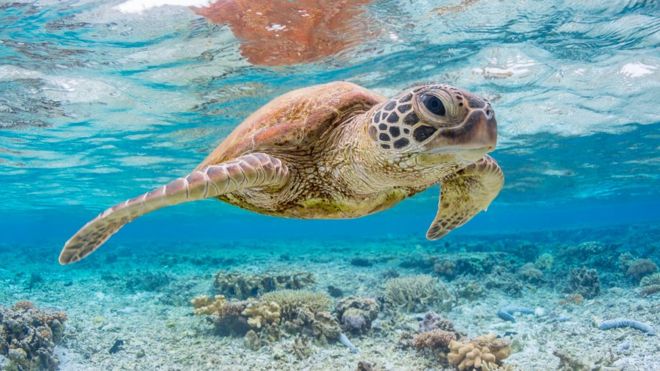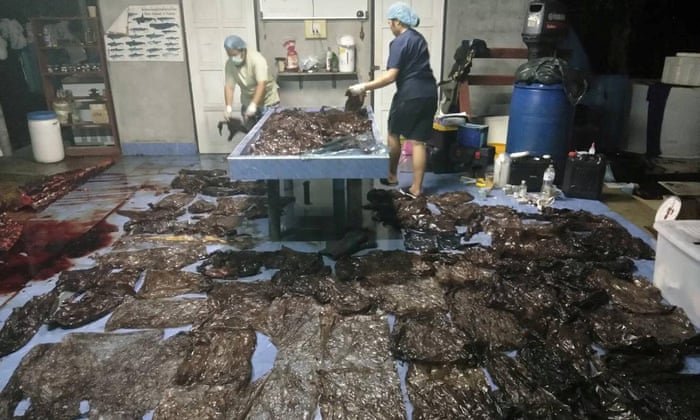Marine Animals in Peril
"I spent all of my undergrad and my masters referencing this [2006 overview of the world's fresh waters] paper, and it was just becoming outdated."
"A lot of the threats are still present, but so many new ones have emerged. There are now 3,700 major hydro power dams that are either planned or under construction [many of them in India and South America]."
"We're seeing there is definitely a shift [in chemicals]. We are seeing a lot of pharmaceuticals in water, like antibiotics that are accumulating in the river systems and are going without treatment."
"For the most part [unused pills flushed down the toilet] they get into the ecosystem undetected. [Other pollutants cause] a range of impacts [on fish] ranging from reduced abundance of fish to effects on individual fish [as, for example] inter-sex fish ... that are essentially stuck between two sexes."
"They are happening under the water's surface and there aren't the same cheerleaders for these lesser-known fish as there are for the killer whales off the coast, or seals. They really do get forgotten. We can monitor things on a huge scale. We can monitor an entire drainage basin and know what's in the fresh water and in the terrestrial habitat."
Andrea Reid, Doctoral biologist candidate, Carleton University
"They [researchers] are now finding fewer inter-sex fish in the Grand [River]."
"[This overview of issues] will keep the alarm bells ringing. We need to keep looking forward instead of being reactive. .. But within all of this there is also some optimism, I think. People do care, [and] there are some advances in water treatment."
"But some of these [conservation measures] are not engineering changes. They are about wholesale changes in human behaviour."
Steven Cooke, biology professor, Carleton University, Ottawa
 |
| Palau National Marine Sanctuary, Indonesia |
The ecological threats faced by fish today endanger their existence in a way unknown generations ago. The presence of antibiotics in water systems along with micro-plastics pose lethal threats to the survival of fish. Then there is the plight of exotic fish that people buy over the Internet and once they become too large to manage they are dumped into Canadian waters. Canada does not yet and perhaps never will experience the issue of large, dangerous fish and reptiles that the Florida Everglades has undergone, when exotic fish and reptile owners 'free' their fish into the wild.
 |
An Argentine black and white tegu is
caught in one of 160-plus traps set out by a University of Florida
research team. The group collaborates with the Florida Fish and Wildlife
Conservation Commission, the National Park Service, the U.S. Geological
Survey, the U.S. Fish and Wildlife Service, and the South Florida Water
Management District to contain and reduce the tegu population Photo: Karine Aigner
|
Among threats to fish life, dams have been blocking rivers to produce hydroelectric power, a situation that has been many decades in the making, and their presence by happenstance prevents fish from their customary biological imprinting; migrating up and down waterways as they hatch, mature and return to their native waters to spawn. Fish 'ladders' put in place in dams have partially solved the problem, and in North America some of those dams have been removed to restore natural aquatic habitation.
The concerns over the omnipresence of microplastics in the world's waterways relate in part to the deleterious effects on aquatic life of which fish represent a large portion. Plastics of every size and shape have been implicated in the deaths of whales, turtles and other aquatic wildlife who ingest plastic but are unable to digest these substances with no nutritional value as they it end up mutilating their interiors, and tangling their fins.
An estimated million seabirds die annually resulting from ocean pollution and ingestion or entanglement in marine debris. Even marine debris like discarded fishing lines and nets create deadly hazards for marine animals when they are directly or indirectly thrown into rivers, oceans and lakes. About 80 percent of plastic trash originates from landfills, washing into rivers and reaching oceans where sharks can become entangled and coral reefs damaged.
 |
| A new study suggests that ingesting even a single piece of plastic can be deadly for sea turtles. Google |
And although pollutants from chemicals have been around for quite a while, there has been a notable increase of their presence as people are increasingly prescribed medicinal drugs, excreting them in their urine where they reach waterways and impact on fish and other marine creatures. Sewage treatment plants remove solids and kill germs, they have not been designed to remove chemicals. when people flush down unused pills or excrete them in urine, fish absorb them in their habitat.
The result is fish have fewer offspring, or offspring whose genetic material has been damaged. Most of these impacts occur downstream from urban centres. There have been changes for the better; locally a sewage plant in Kitchener-Waterloo, Ontario has been upgraded to remove many pharmaceuticals and the result is that researchers are finding fewer fish being deleteriously impacted.
Researchers also use environmental DNA (eDNA), genetic traces left by animals in water or on land when they slough off bits of skin or scales or leave droppings. Samples are taken to learn how species interact, a monitoring that makes available solid information to governments and regulators who can respond by designing conservation measures that answer to any given identified need.
But there is always another important part of the puzzle, and that involves the public, and awareness. That it is not positive ecological practise to thoughtlessly dump medicine into a toilet, but to return unused pills to the pharmacy where they were bought. And to take care with their plastic discards by reusing or recycling them, for starters, and just perhaps buying less of disposable plastic 'conveniences'.
 |
| Some of the plastic bags extracted from a whale’s stomach in Thailand. Photograph: Social Media/Reuters |
Labels: Aquatic Wildlife, Biodiversity, Chemicals, Plastics, Research


0 Comments:
Post a Comment
<< Home